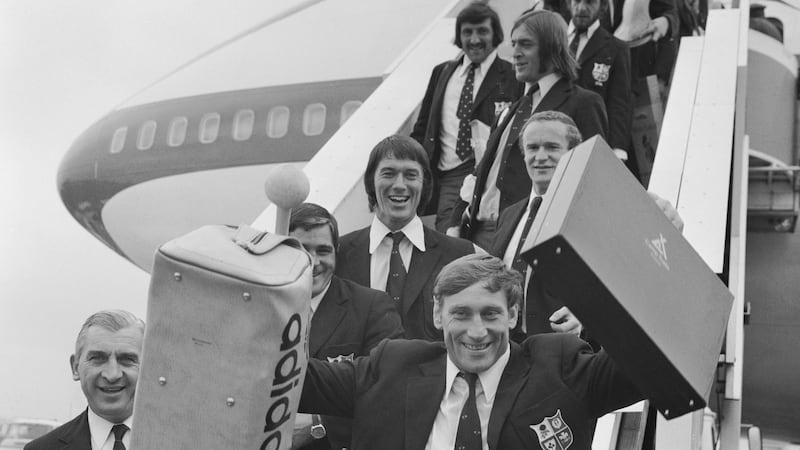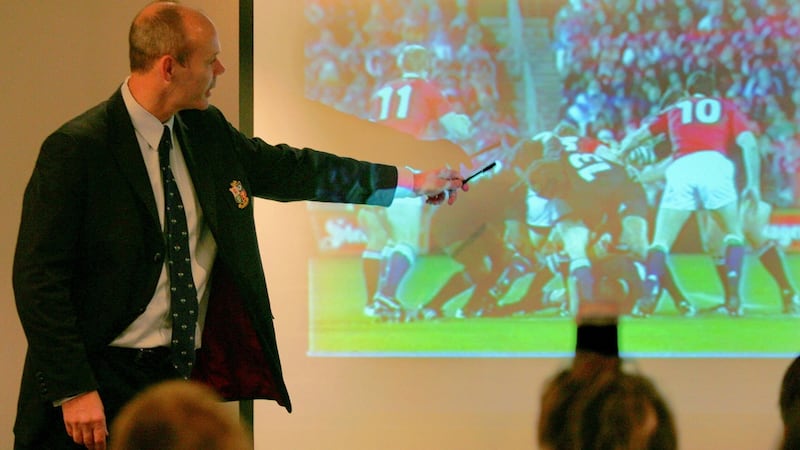Violent. Intense. Intoxicating. And so another Lions tour is sprung on two hemispheres. A chain of warm up matches whet appetites before Warren Gatland's side even reach the starting line of the first game against New Zealand in Eden Park on June 24th.
Like a linked-arm tunnel of kicks and thumps as any boy in the school yard has had to run, so a bloody and physical challenge has become embedded in the folklore of the touring British and Irish Lions. A brief history of violence, this year in 10 hostile steps.
How far do we want to go back and who orchestrated the assaults has become part of history with right or wrong depending on who you ask but always ‘more please.’
It gives the tour a strictly non-PC edge, a few stitches, a sore jaw, broken fingers and best of all carry over grudge.
From the famous 13 unanswered punches to the face of Ronan O’Gara in 2001 to the spear tackle of Brian O’Driscoll or in 1974 the 99 call against the Springboks and the ‘Battle of Ballymore, the history of Lions tours is scarred by memorable dust ups.
The seven warm up matches are a protracted trial for all aspiring New Zealanders with provincial players eager to please and for towns and hamlets to glory in going hand to hand.
It's an assault course as much as a tour
Unashamedly old school, a softening up process strung out over weeks in a program that no modern national coach would consider.
It’s an assault course as much as a tour; a marching Lions’ army to be stopped at every outpost one way or another. It is a challenge thrown down at every step.
1968 Lions v Eastern Transvaal
According to the former Wales Lion John Taylor, the famous Willie John McBride 99 call originated in this tour but blossomed in the next one to South Africa.
It came from an incident that put John O’Shea in an historical context as the first Lion to get sent off during a tour. In 2013, Taylor recalled that a scuffle broke out amongst the forwards. But O’Shea became isolated by half a dozen home forwards and was singled out by the referee as the only Lion involved. He was dismissed.
On leaving the pitch O’Shea was punched by a spectator triggering a tunnel brawl that involved reserves, officials and police as play continued.
Willie John McBride rushed down from the stand to offer protection, dealing peremptorily with one fan as he tried to attack his team mate. This, said Taylor, was the genesis of the infamous ‘99’ call six years later in 1974.
1971 Lions v Canterbury
The Lions won the match 14-3 but lost their two best props, Ray McLoughlin to a chipped bone at the base of his left thumb and Sandy Carmichael to a multiple fracture of his cheekbone.
Things went on that day in 1971 that had no place on a rugby field
Carmichael was persistently boring in on Tane Norton, the Canterbury hooker, was warned by Alister Hopkinson, the opposing prop and was punched more than once for his trouble.
The blow that fractured Carmichael’s cheek bone in five places came later after a back handed fist hit him at the tail of a lineout.
McLoughlin was injured when a fight erupted with players from both sides weighing into each other near the touchline.
The Irishman punched Grizz Wyllie in the head, breaking his left thumb, while Fergus Slattery, was punched in the face after unwisely hanging on to Wyllie’s jersey in a line-out. “Things went on that day in 1971 that had no place on a rugby field,” said Gerald Davies.
“We lost both our props for the rest of the tour and at one point our captain, John Dawes, asked the referee to watch what was happening off the ball. His reply was that what happened behind his back was of no concern to him.”
Gareth Edwards later described it as the only time in his career that he felt threatened for his life on a rugby field.
Lions v South Africa 1974
It was the fourth match of the Lions tour when South Africa coach, Johan Claassen, was reported to have gone into the home dressing room and instructed the players to grind the Lions into the dust.
Players do as players must with second row Gordon Brown an early casualty of being butted on the face on the ground. Incidents flared up all around the ground prompting Gareth Edwards to ask captain, Hannes Marais, to cut the cheap shots.
That game against Eastern Province paved the way for the battle of Boet Erasmus Stadium, one of the most violent matches in rugby history.
It made the tour of ‘The Invincibles’ memorably infamous, not for 22 games unbeaten and a 3-0 triumph in the Test series, but for the infamous “99” battle cry - the call to arms that resulted in one of the most documented punch-ups in rugby history.

When Willie John McBride called 99 every player, in an act of unity as much as violence, hit the person beside them. The theory ran that the referee could not police every incident or send off every player.
There is famous video footage of Lions fullback J.P.R. Williams running over half of the pitch from his own 22 and launching himself at Moaner van Heerden, something Williams now says does not make him proud.
These days, said one commentator at the time, the ball is no longer an impediment to an afternoon of sport.
1997 Lions v Mpumalanga Pumas
It was the Lions first game at altitude and they were expecting a red mist to descend over the Johann van Riebeeck Stadium facing into the Mpumalanga Pumas.
In that the Pumas did not disappoint. Out classed in the game, they made marks of sorts elsewhere in the match.
Elandre van der Bergh, the culprit when Jon Callard was disfigured in Port Elizabeth in 1994, re-established his reputation in that sphere when he reportedly river danced all over Rob Wainwright at a 24th-minute ruck.
Van der Bergh’s second-row partner, Marius Bosman, also made a contribution to sick bay by stamping on Doddie Weir’s left knee, which ended his tour.
The Scotsman’s knee was so savagely attacked that the ligaments were ruptured with Bosman fined £1,400, but not banned.
“The stamp on Doddie was a cold-blooded act,” said an incandescent Ian McGeechan, the Lions coach.
1989 Lions v Australia 2nd Test
It was to become Battle of Ballymore. Outscored by four tries to nil in the first Test, the Lions had been outfought and out-thought. Surveying the wreckage with just six days to prepare for the second Test, they were licking their wounds.
There was agreement among the players that they would not take a step back and would go down fighting. Perhaps contrary to the tradition of the forwards kicking things off in rucks and mauls, it was scrumhalf Rob Jones, who set the tone.
At a scrum, Jones tread on the foot of his opposite number Nick Farr-Jones, prompting a free-for-all involving both packs, French referee Rene Hourquet ending up grappling on the deck with both players.
More was to follow, when prop Dai Young’s kick aimed at Steve Cutler’s head in a ruck set the wheels in motion for another all-in.
Four Australians, Greg Martin, Steve Tuynman, Michael Lynagh and Farr-Jones, would finish the match with a total of 25 stitches between them.
The Lions aggressive approach was widely condemned, especially in Australia, the tourists reasoning pragmatically that the ends justified the means.
2001 Lions v New South Wales Waratahs
On the ground and removed from the play, all that is visible is a prone player and the swinging arm of another. At almost 15 minutes into the second half it is Ronan O’Gara on the ground and Waratahs’ fullback Duncan McRae raining in the blows onto his hidden face.
We wanted to make a statement in the build-up to the Test series
When McRae is pulled off by one of his own players, the Lions medics have one look at O’Gara and escort him from the pitch to the locker room, where a syringe needle is immediately pushed into the already burgundy and badly swollen eye before the stitches start to go in.
“Fucking cheap shots,” said O’Gara breathing heavily on the bed with his hands behind his head, the doctors working on his face.
“Caught me with the first one. Couldn’t fucking defend myself. Fucking trying to look after the ball.”
Mc Rae had punched O’Gara 11 times resulting in eight stitches to the Irish player’s left eye. The Australian, who was shown a red card, was subsequently given a seven week ban. However, as it was the off-season, the seven week ban amounted to a zero game ban.
‘We wanted to make a statement in the build-up to the Test series... and bash them up a bit before the Tests,” said McRae afterwards.
2005 Lions v New Zealand 1st Test
As perfect as any premeditated attack can be, in tandem with his hooker, Kevan Mealamu, centre Tana Umaga ended Lions and Ireland centre Brian O’Driscoll’s tour after just 41 seconds of the first Test in Christchurch.

It was an off the ball incident that as much summed up the O’Driscoll threat to the All Blacks as the home side’s ruthless efficiency in carrying out their work.
In a manoeuvre that is now outlawed by World Rugby the players took a leg each of O’Driscoll as he packed down at the back of a ruck. They violently turned him upside down and then drove him into the ground.
Mercifully O’Driscoll’s instinct was to put out his arm in order to take the force of the drive and save his head and neck. The impact of the spear tackle, however, dislocated his shoulder forcing him to leave the pitch in a motorised car.
Replays show the ball was in the hands of New Zealand lock Ali Williams 15 metres away when O’Driscoll was “slam-dunked” into the ground and subsequently out of the game for seven months following an operation on his shoulder.
In Umaga’s book ‘Up Close’ published in 2007, his mood was far from contrite and called O’Driscoll a ‘sook’ or cry baby.













